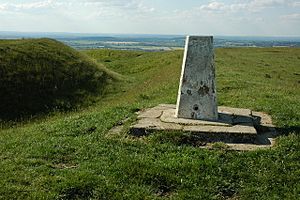Uffington Castle facts for kids

Ramparts of Uffington Castle at Whitehorse Hill, the highest point in Oxfordshire.
|
|
| Location | Whitehorse Hill, between Swindon and Wantage. (SU299863) |
|---|---|
| Region | Oxfordshire England |
| Coordinates | 51°34′30″N 1°34′09″W / 51.5750587°N 1.5692032°W |
| Type | Hillfort |
| History | |
| Periods | Iron Age |
| Site notes | |
| Excavation dates | 1995 |
| Archaeologists | David Miles, Oxford Archaeological Unit |
| Condition | substantial earthworks |
| Public access | Yes |
| Website | English Heritage |
| Designated | 1882 |
| Reference no. | 1008412 |
Uffington Castle is an ancient hillfort found in Oxfordshire, England. It was first built during the Iron Age, but there are also signs of even older activity from the Bronze Age.
This hillfort covers a large area, about 32,000 square metres. It has two big earth banks with a ditch in between them. There was an entrance on the western side. Another entrance on the eastern side was closed up a few hundred years after the fort was built.
The first defensive ditch was shaped like a "V". It had a small earth wall in front and a bigger one behind it. Wooden posts stood on top of these walls. Later, the ditch was made deeper. The extra earth was used to make the walls even bigger. The top of the inner wall was lined with large, hard stones called sarsen stones. Uffington Castle is very close to the famous Uffington White Horse on White Horse Hill.
Contents
Uncovering Uffington Castle's Past
What We Learned from Digs
Archaeologists have dug at Uffington Castle to learn more about it. They believe it was built around 700 or 800 BC. People continued to live there throughout the Iron Age.
Inside the fort, they found isolated postholes. These are marks in the ground where wooden posts once stood. However, they didn't find clear signs of buildings.
Evidence of Life Inside
Even without buildings, other finds suggest people lived there. Archaeologists found pieces of pottery, tools for weaving cloth (called loom weights), and animal bones. This tells us that people were living, eating, and making things inside the fort.
Roman Times at the Fort
The most activity at Uffington Castle seems to have been during the Roman period. Many old objects, or artefacts, were found in the upper parts of the ditch. These objects show that the Romans used the site.
During this time, the earth walls were changed to create more entrances. It also looks like a special place for worship, called a shrine, was built around 300 AD. Nearby, archaeologists found two oblong mounds. One held the remains of 46 people from the Romano-British period (when Romans were in Britain). The other mound contained eight burials from the Saxon period.
The Ancient Ridgeway Path
An old path, known as The Ridgeway, runs right past the northern entrance of the hillfort. This path is very old. It connects to another ancient route called the Icknield Way.
The Ridgeway also passes close to Avebury, a famous ancient stone circle. From there, it goes south across Salisbury Plain. It also goes very near to Waylands Smithy. This is a Neolithic chambered long barrow, which is an ancient burial mound. It's about a mile to the west of Uffington Castle.
Protecting This Historic Site
A Special Protected Place
Uffington Castle is a very important historical site. It is listed as a Scheduled Ancient Monument. This means it has special legal protection. It was one of the first 68 sites in Britain and Ireland to get this protection back in 1882.
Cared for by English Heritage
Both Uffington Castle and the Uffington White Horse are looked after by English Heritage. This organization helps preserve important historical places in England. They make sure these sites are protected for future generations to visit and learn from.
See also
 In Spanish: Castillo de Uffington para niños
In Spanish: Castillo de Uffington para niños





